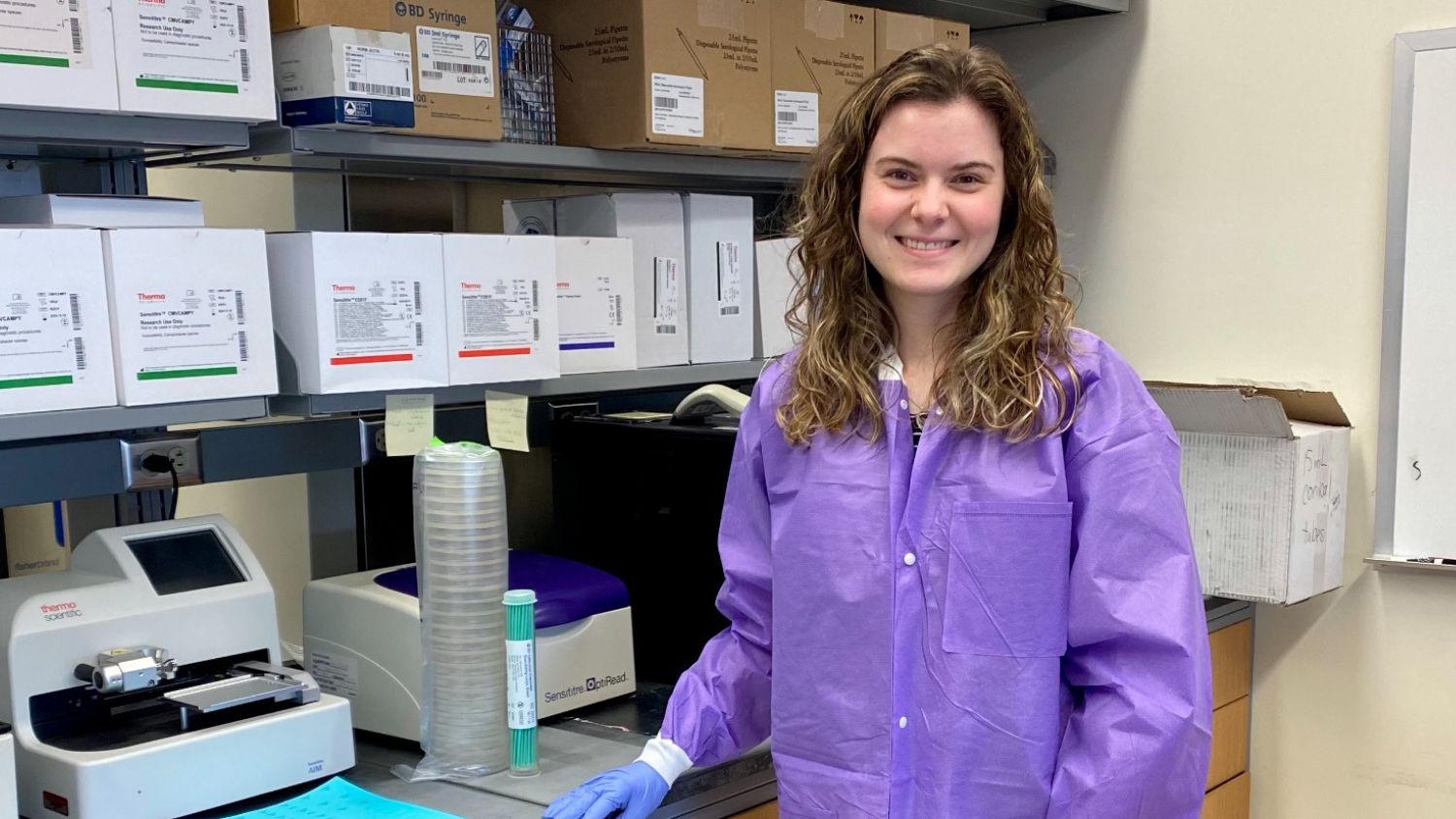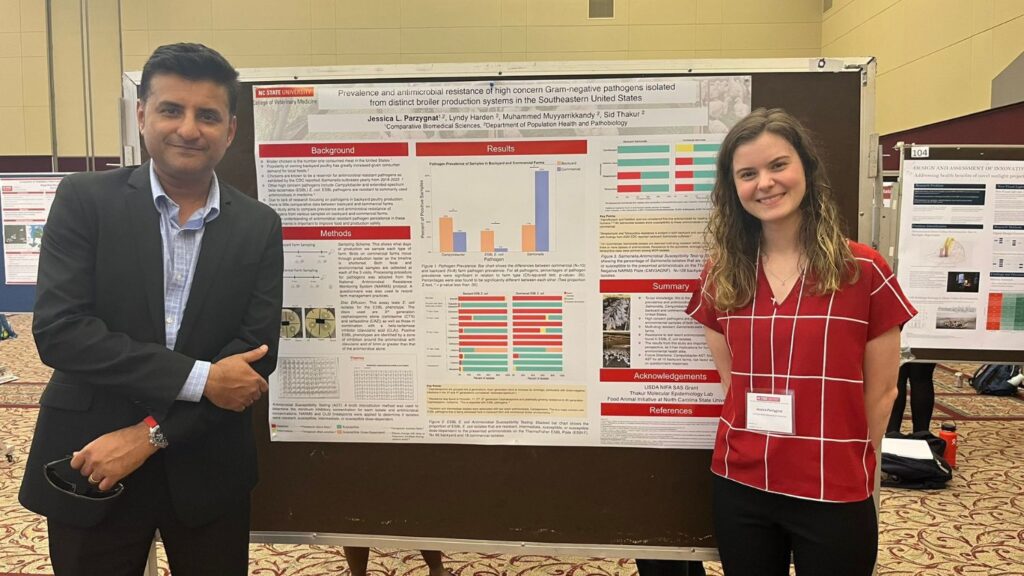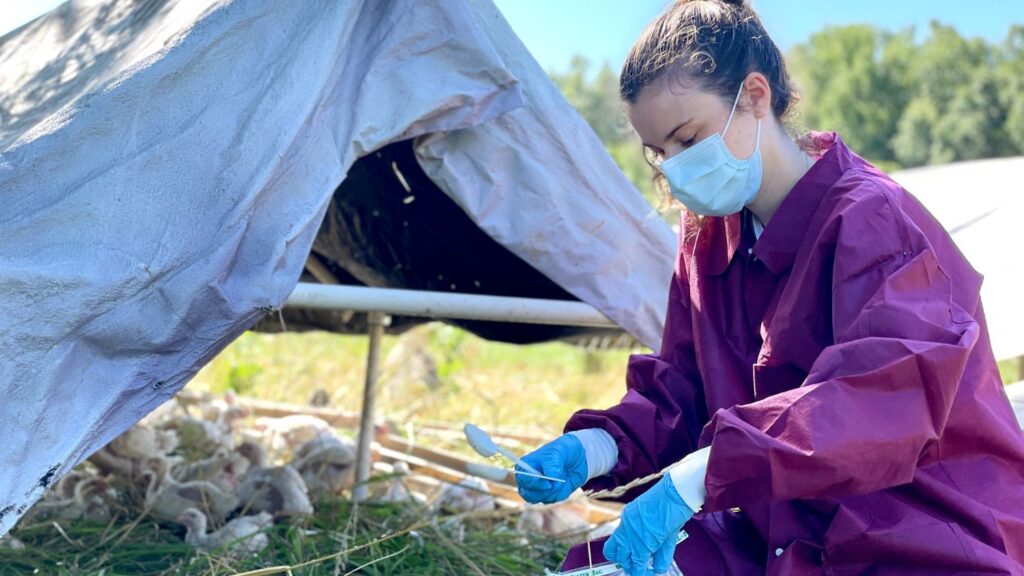The Rise of Antimicrobial Resistance

When you get sick, you might be prescribed an antibiotic. However, that treatment might not work if the bacteria are resistant.
“If someone were to get sick with a bacterial infection and that bacteria is resistant to the antimicrobials used to treat it, that’s a really scary situation that we’re facing now and going to be facing into the future,” says Jessica Parzygnat, a ‘19 animal science graduate and current doctoral student and North Carolina Food Animal Initiative Fellow.
Parzygnat is studying the molecular epidemiology of antimicrobial resistance on poultry farms. Broiler chicken is the top meat consumed in the United States, and chickens naturally have bacteria such as E.coli and Salmonella and Campylobacter in their guts. Although the bacteria often don’t harm the chickens, pathogens — including those that are resistant to antimicrobials — can be transferred to humans, putting their health at risk.
Following a Dream
Parzygnat’s passion for animals — and North Carolina State University — began when she was young.
“I grew up an NC State Wolfpack fan because my grandfather, both my parents, both my uncles and one of my aunts all went to NC State,” says Parzygnat. “My brother is studying engineering here. My fiance also graduated in 2019 with an animal science degree. I grew up going to football and basketball games, and my parents took me on campus a lot to get ice cream from Howling Cow.”

While growing up in Apex, North Carolina, her family had dogs, and she loved visiting her great-aunt’s farm.
“It was a dream of mine to attend NC State in the first place, but I also had a very big interest in animals,” Parzygnat says.
Parzygnat decided to study animal science with an initial goal of becoming a vet. She was also in the University Scholars Program and the Animal Science Club, which gave her the opportunity to participate in extra research projects and work with many different kinds of animals.
Choosing Research
Parzygnat discovered another interest during an Introduction to Microbiology course.
“Animal science and microbiology are intertwined, so even though I wasn’t planning on it initially, I minored in microbiology,” Parzygnat says.
She then decided she no longer wanted to be a vet and instead focused on research on the relationship between animals and microbes. Following graduation, Parzygnat enrolled in the College of Veterinary Medicine’s (CVM) Comparative Biomedical Sciences Program to work with Siddhartha Thakur.
“I was really excited about the project having to do with chickens and bacteria that can make people sick,” Parzygnat says. “This project combines both of my interests, and my undergrad experience really helped prepare me for jumping into a Ph.D.”

As a Food Animal Initiative Fellow, Parzygnat is also supported by the College of Agriculture and Life Sciences (CALS).
“I get to be a bridge between CALS and CVM,” she says. “That’s another bonus of this project that I have. Even though I’m in the program at the vet school, I get mentorship from all around.”
Pathogens on Farms
She spent the first three years of her doctoral work visiting commercial and backyard farms across North Carolina to collect fecal and environmental samples. She then processed those samples and tested the bacteria for antimicrobial resistance.
Parzygnat’s initial findings — which won first place in the life sciences category at the 16th annual Graduate Student Research Symposium — show the prevalence of antimicrobial-resistant bacteria is high, so she’s trying to find out what’s causing it and how to prevent it from getting worse.

“I am finding pathogens at multiple sites on farms,” Parzygnat says. “I’m finding it in the environment. I’m finding it in fecal samples from birds. I’m also finding resistance, even some resistance to carbapenems, which are known as a last resort antimicrobial for multi-drug resistant infections. That kind of resistance could be in someone’s backyard.”
To understand why she’s seeing resistance, even without the use of antibiotics on farms, Parzygnat is using a questionnaire on farm management practices to determine if there’s an association between practices and bacteria found.
As Parzygnat continues her research, she has advice to help curb an increase in future resistance and keep yourself safe.
“People ask me what they can do, and right now, I can help identify the sources of these pathogens on farms, but I am still confirming my results using genomic approaches. At this stage, I would say to be aware of what you’re touching and always wash your hands afterward.”
- Categories:


